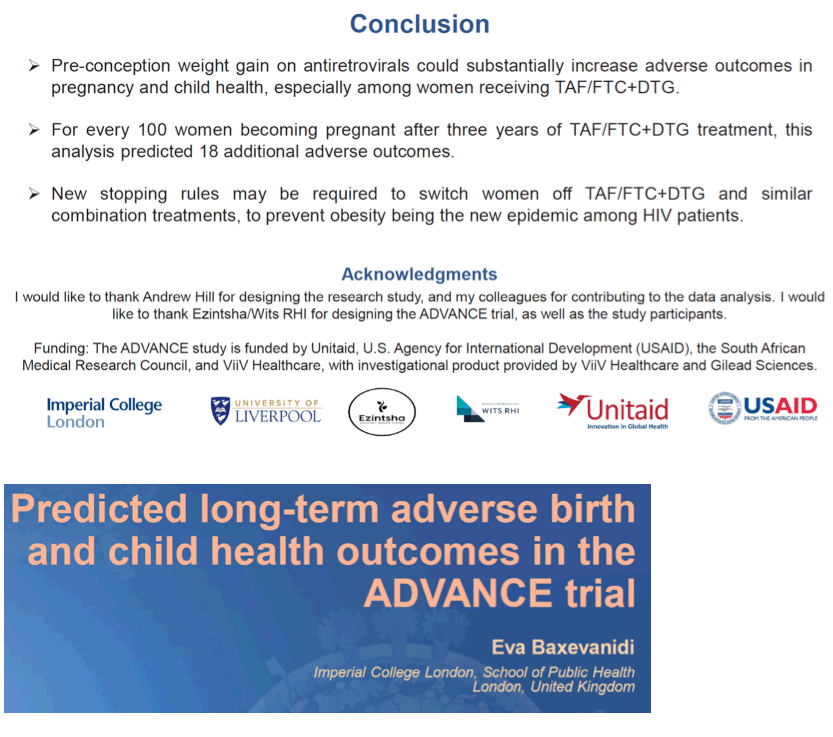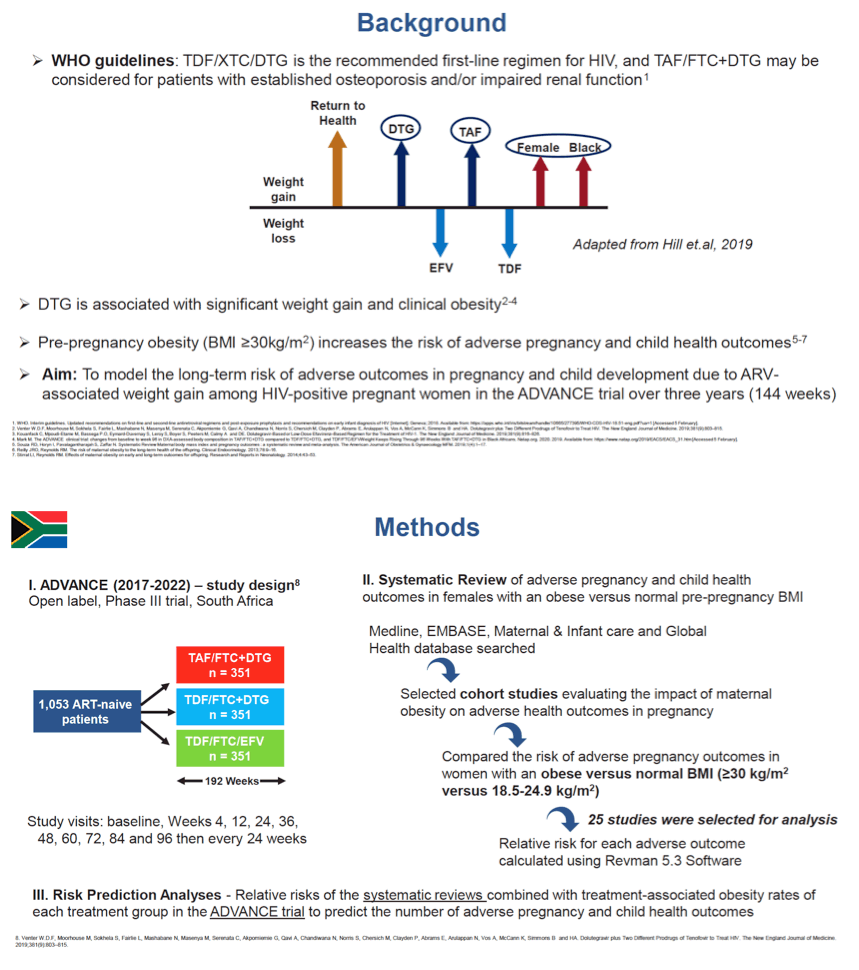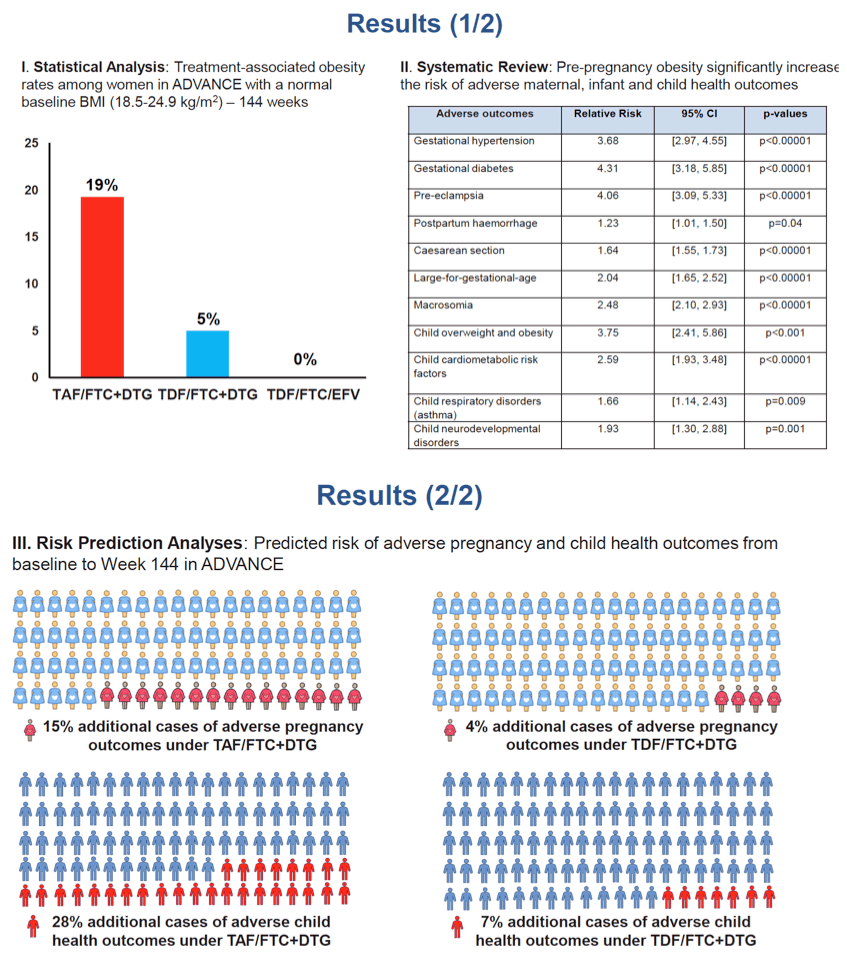 |
 |
 |
| |
PREDICTED LONG-TERM ADVERSE BIRTH AND CHILD HEALTH OUTCOMES IN THE ADVANCE TRIAL
|
| |
| |
CROI: DOLUTEGRAVIR-BASED ART IS SUPERIOR TO NNRTI/PI-BASED ART IN CHILDREN AND ADOLESCENTS - (03/10/21)
CROI: MATERNAL WEIGHT AND ADVERSE PREGNANCY OUTCOMES AMONG WOMEN ON ART AT CONCEPTION - (03/11/21)
CROI: ANTEPARTUM WEIGHT GAIN AND ADVERSE PREGNANCY OUTCOMES IN IMPAACT 2010 - (03/11/21)
CROI: SAFETY/EFFICACY OF DTG VS EFV, TDF VS TAF IN PREGNANCY/POSTPARTUM: IMPAACT 2010 TRIAL - (03/11/21)
CROI: DoLPHIN2 FINAL RESULTS DOLUTEGRAVIR VS EFAVIRENZ IN LATE PREGNANCY TO 72W POSTPARTUM - (03/10/21)
CROI 2021 March 6-10 Reported by Jules Levin
Evangelia E . Baxevanidi1, Sumbul Asif2, Ambar Qavi1, Andrew Hill3, Francois Venter4, Fairlie Lee5, Masebole Masenya5, Celicia M. Serenata4, Simiso Sokhela4, Nomathemba Chandiwana4
1Imperial College London, London, UK, 2University of Leeds, Leeds, UK, 3University of Liverpool, Liverpool, UK, 4Ezintsha, University of the Witwatersrand, Johannesburg, South Africa, 5Wits RHI, University of the Witwatersrand, Johannesburg, South Africa
Background: First-line treatment with the integrase inhibitor dolutegravir (DTG) is associated with significant and progressive weight gain, especially among black women and if combined with TAF/FTC. If women become clinically obese after long-term treatment, this could increase risks of adverse birth and child health outcomes. This analysis assessed long-term risks of adverse outcomes in pregnancy and child health from treatment-associated clinical obesity among pregnant women, using data from the ADVANCE trial.
Methods: In the ADVANCE trial treatment-naïve patients were randomised to TAF/FTC+DTG, TDF/FTC+DTG or TDF/FTC/EFV for 144 weeks. A systematic review analysed the association between pre-pregnancy obesity and adverse maternal and infant outcomes. The association between pre-pregnancy obesity and adverse outcomes in child health (ages 6-16) was also measured. Risk ratios using the Mantel-Haenzsel test with random-effects were calculated. Risk ratios of the pregnancy and child health outcomes were combined with treatment- associated obesity rates from ADVANCE to predict the number of women, infants and children who could experience adverse events in each arm at Week 144.
Results: After 144 weeks of treatment in the ADVANCE trial, the percentage of women with normal baseline BMI becoming clinically obese was 19% for TAF/ FTC+DTG, 5% for TDF/FTC+DTG, and 0% for TDF/FTC/EFV. From baseline to Week 144, the predicted increase of adverse maternal outcomes was 15% with TAF/ FTC+DTG versus 4% with TDF/FTC+DTG, whereas risk predictions for adverse infant outcomes were 12% and 3% in these two treatment groups. Similarly, the predicted risk of adverse outcomes in child health was 28% and 7% on TAF/ FTC+DTG and TDF/FTC+DTG, respectively. No additional adverse events were predicted for pregnant women treated with TDF/FTC/EFV.
Conclusion: Pre-conception weight gain on antiretrovirals could substantially increase adverse outcomes in pregnancy and child health. There are consistent associations between pre-pregnancy clinical obesity and higher risks of adverse maternal, infant and child health outcomes. For every 100 women becoming pregnant after three years of TAF/FTC+DTG treatment, this analysis predicted 18 additional adverse outcomes. New stopping rules may be required to switch women off TAF/FTC+DTG and similar combination treatments, to lessen these risks.



|
| |
|
 |
 |
|
|